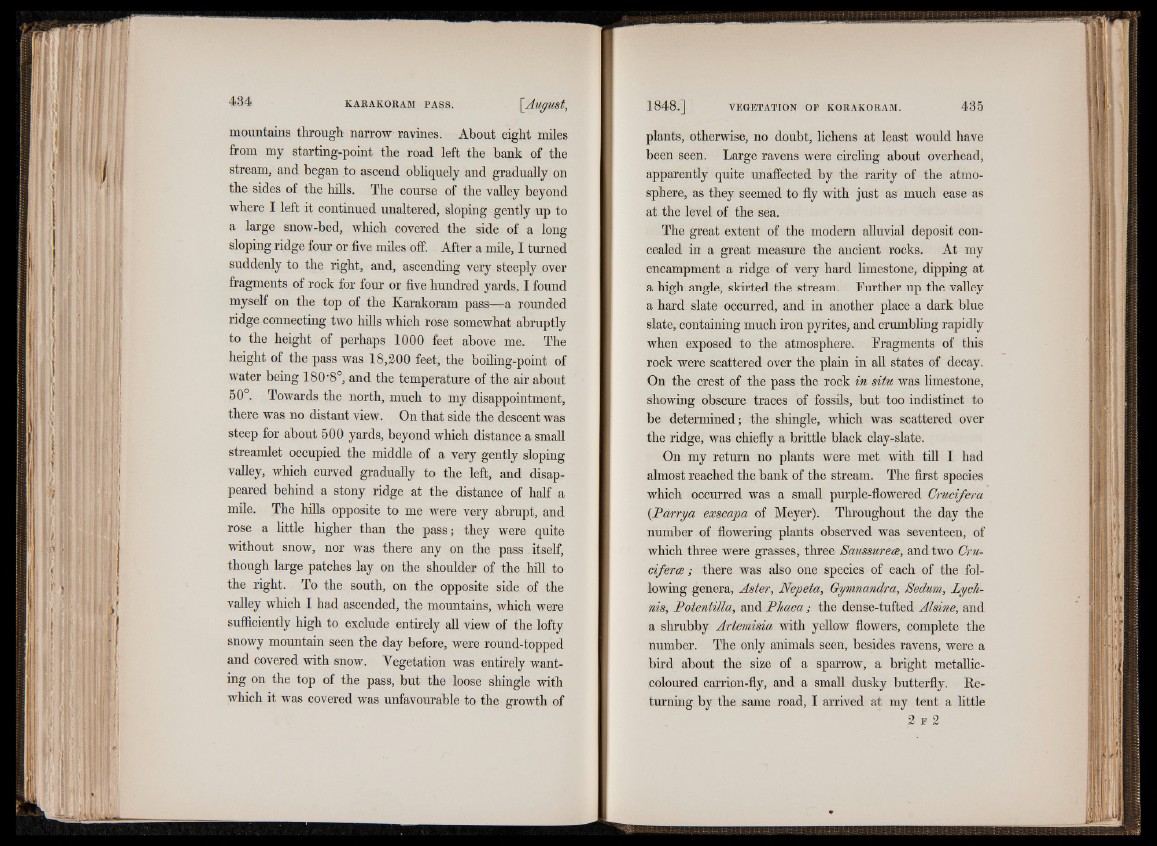
mountains through: narrow ravines. About eight miles
from my starting-point the road left the bank of the
stream, and began to ascend obliquely and gradually on
the sides of the hills. The course of the valley beyond
where I left it continued unaltered, sloping gently up to
a large snow-bed, which covered the side of a long
sloping ridge four or five miles off. After a mile, I turned
suddenly to the right, and, ascending very steeply over
fragments of rock for four or five hundred yards, I found
myself on the top of the Karakoram pass—a rounded
ridge connecting two hills which rose somewhat abruptly
to the height of perhaps 1000 feet above me. The
height of the pass was 18,200 feet, the boiling-point of
water being 180-8°, and the temperature of the air about
50°. Towards the north, much to my disappointment,
there was no distant view. On that side the descent was
steep for about 500 yards, beyond which distance a small
streamlet occupied the middle of a very gently sloping
valley, which curved gradually to the left, and disappeared
behind a stony ridge at the distance of half a
mile. The hills opposite to me were very abrupt, and
rose a little higher than the pass; they were quite
without snow, nor was there any on the pass . itself,
though large patches lay on the shoulder of the hill to
the right. To the south, on the opposite side of the
valley which I had ascended, the mountains, which were
sufficiently high to exclude entirely all view of the lofty
snowy mountain seen the day before, were round-topped
and covered with snow. Vegetation was entirely wanting
on the top of the pass, but the loose shingle with
which it was covered was unfavourable to the growth of
plants, otherwise, no doubt, lichens at least would have
been seen. Large ravens were circling about overhead,
apparently quite unaffected by the rarity of the atmosphere,
as they seemed to fly with just as much ease as
at the level of the sea.
The great extent of the modern alluvial deposit concealed
in a great measure the ancient rocks. At my
encampment a ridge of very hard limestone, dipping at
a high angle, skirted the stream. Further up the valley
a hard slate occurred, and in another place a dark blue
slate, containing much iron pyrites, and crumbling rapidly
when exposed to the atmosphere. Fragments of this
rock were scattered over the plain in all states of decay.
On the crest of the pass the rock in situ was limestone,
showing obscure traces of fossils, but too indistinct to
be determined; the shingle, which was scattered over
the ridge, was chiefly a brittle black clay-slate.
On my return no plants were met with till I had
almost reached the bank of the stream. The first species
which occurred was a small purple-flowered Crucifera
{Párrya exscapa of Meyer). Throughout the day the
number of flowering plants observed was seventeen, of
which three were grasses, three Saussurece, and two Crucifera}
; there was also one species of each of the following
genera, Aster, Nepeta, Gymnandra, Sedum, lych nis,
Botentilla, and Phaca ; the dense-tufted Alsine, and
a shrubby Artemisia with yellow flowers, complete the
number. The only animals seen, besides ravens, were a
bird about the size of a sparrow, a bright metallic-
coloured carrion-fly, and a small dusky butterfly. Returning
by the same road, I arrived at my tent a little
2 f 2